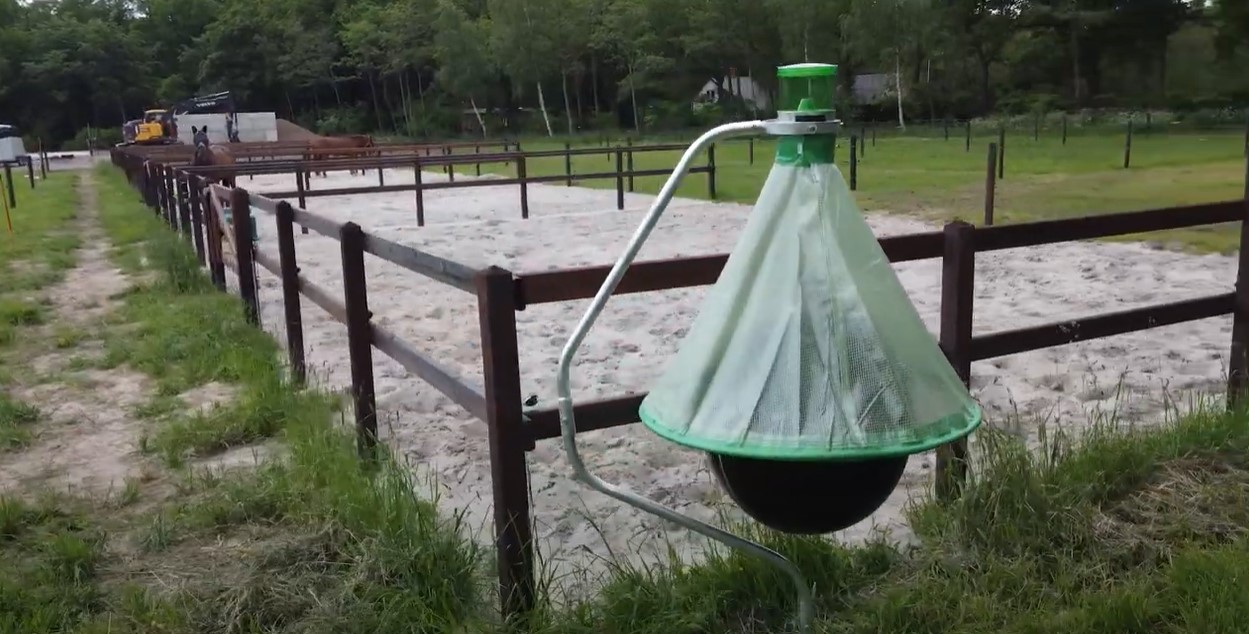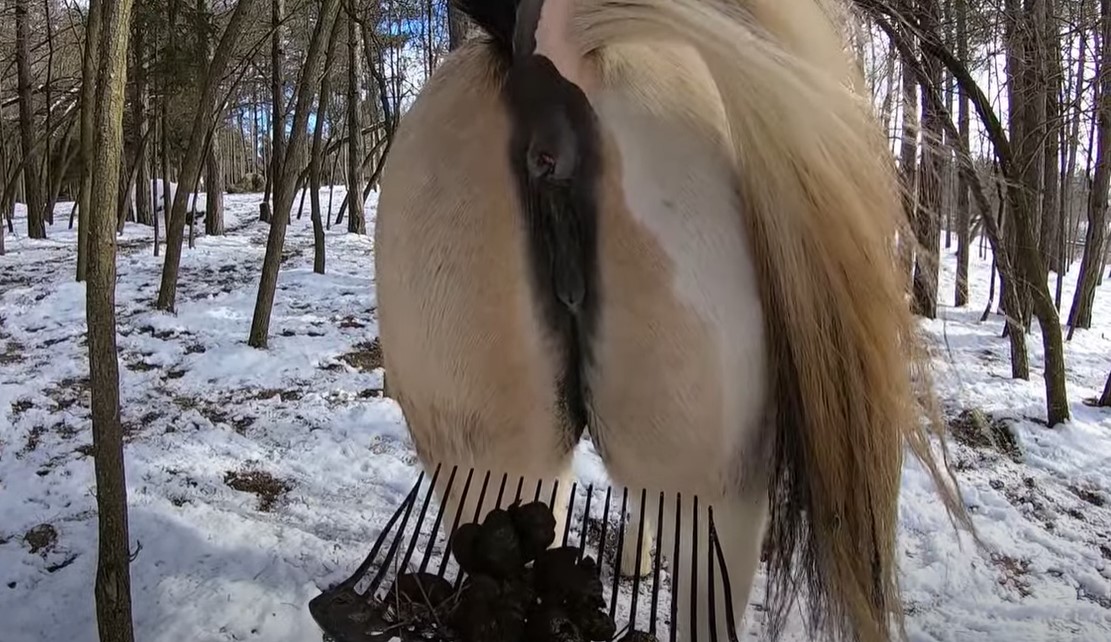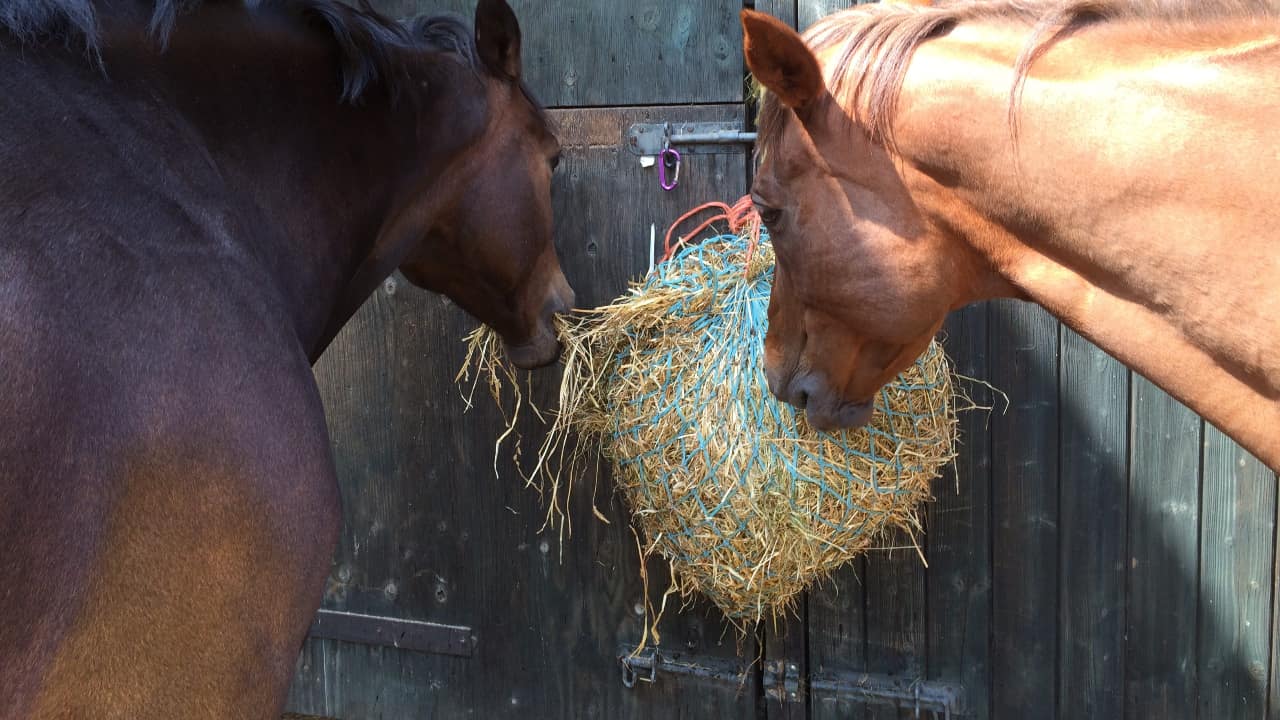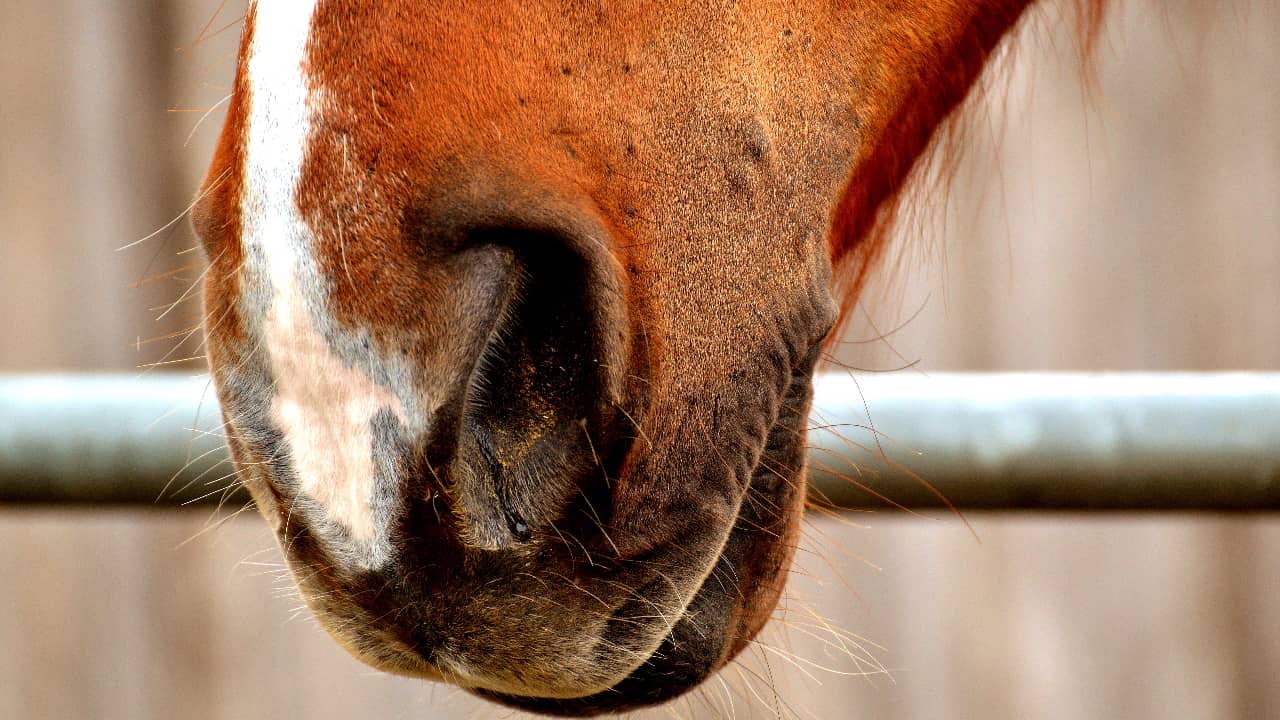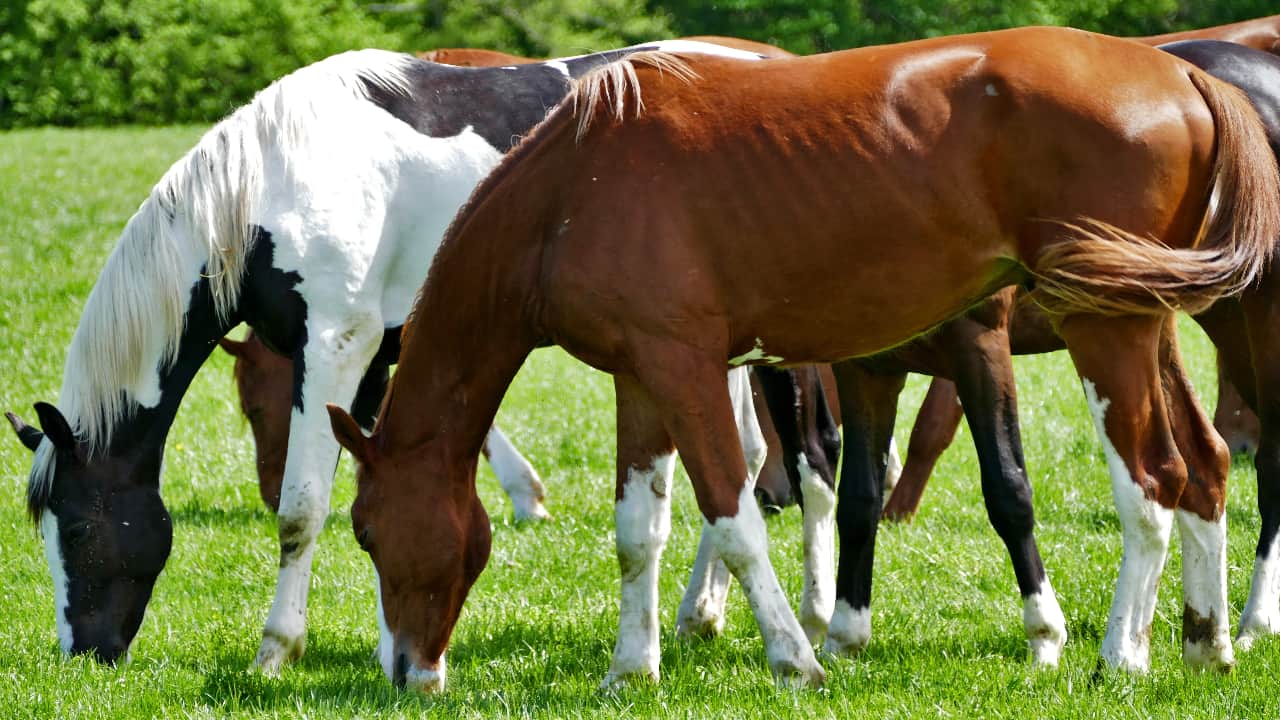Flies, mosquitoes, and other flying insects can become a major cause of irritation for horses. But aside from simply being a nuisance, these pests also bring disease and infections like vector born equine diseases which may put your horse's health at risk.
If flies and other winged pests have become an issue on your ranch, then it's time to look for the best horse fly traps. Not sure which ones work best? Here's a list of our most vetted choices.
The 6 Best Horse Fly Trap Choices
1. Bug Ball Odorless Fly Trap
The Bug Ball Odorless Fly Trap is a large black ball horse fly trap that you can hang off of a tree or a post to catch a variety of flies. It uses the Catch 'Em Sticky Coating that you purchase separately and smother all over the ball's surface to create an aggressive adhesive film that effectively catches bloodsucking flies, horse flies, deer flies, yellow flies, and other kinds of biting flies.
The eco-friendly wind resistant horse fly trap and coating don't use any toxic ingredients or pesticides, making it a safe choice for any cattle yard or ranch. Ideal for large commercial horse stable yards, just two or three these 18-inch inflatable horse fly traps can effectively cover an acre of farm space.
One of the best ways to protect your beloved horses aside from simply catching existing flies would be to keep them from multiplying all together. The Bite Lite Professional Horse Fly Bug Ball aims to achieve that with its intelligent design that attracts female horse flies to reduce fly populations.
The Bite Lite design lures in female horse flies by way of a unique infrared signature generated by the ball when exposed to heat. The female horse fly will then attempt to bite the Bite Lite Bug Ball. But once the biting female horse fly realizes it can't, it will move on through its natural flight pattern, leading it upwards to the Bite Lite net trap that works to contain the flies and prevent an increase in their numbers.
3. Farnam Home and Garden Starbar Captivator Fly Trap
Fashioned as a large transparent jar, the Farnam Starbar Captivator Horse Fly Trap uses a sex attractant scent that attracts flies by way of powerful pheromones. But because it uses a specific scent that triggers a mating response in flies, it works particularly well to catch female horse flies ready to lay eggs.
Reusable and cost-effective, this horse fly trap can help keep fly populations at bay, making it one of the best outdoor horse fly traps on the scene. With a 2-quart capacity and wind resistant design, this trap can capture a significant number of flies and, according to users, works much better than any government surveillance trap.
Contained in an aerosol can, the Tanglefoot Tangle Trap Sticky Coating works best for farm owners who prefer the perks of a sticky trap. This safe, non toxic bait doesn't use pesticides and works naturally to capture flies and horse fly eggs to keep them them there until they die.
Lots of users who have tried the Tangle Trap Sticky Coating spray the stuff on a variety of items like buckets, fruit, or even sheets of fabric which they then hang up to attract pests. Creating a powerful adhesive surface, the spray gives users the option to fashion their own horse fly trap and use objects and colors that would best attract the kind of pest they're having problems with.
Capable of holding as many as 40,000 flies in a single bag, the Rescue Big Bag Fly Trap can trap horse flies, stable flies, and other biting flies that could pester your animals. The horse fly traps quite literally appear like plastic bags with a distinct top attachment that holds flies inside and keeps them from exiting the system.
Inside the bag is a coating that works to attract various forms of pests. All you need to do is add water and hang the bag in an open area to start catching flies. What's best about the Rescue Bags is that they don't require tedious clean up. Once the disposable trap is full, simply get rid of the disposable traps and replace with a fresh bag.
Made from a fine mesh, this Ranch Horse Fly Trap captures various types of flies by way of a stinky bait of your choosing. The bottom of the horse fly trap features a shallow plastic dish where you can place your bait. A narrow mesh tunnel passes through the center of the structure, leading flies to the bait and leaving them without an exit.
Simple, safe, and effective, this horse fly trap is reusable but doesn't require such tedious cleaning. Simply untie the bottom end to release the dead flies and reset the bait to get the trap back up and ready.
Different Types of Horse Fly Traps
There's more than one way to skin a cat, or in this case, to catch horse flies. Manufacturers offer a variety of horse fly traps that work in different ways. Although some users assert that certain types work better, the main factor affecting your choice would be your own preference.
Horse fly traps fall into two main categories. The first is the method used to attract the pests, and the second is the method used to capture the pests.
Attraction Mechanism
Visual
Research has found that some colors may attract flies better than others. Scientists have long identified the color blue as an attracting color for all sorts of flying pests, so many traps utilize the color in some way in order to appear more appealing to horse flies.
Odor
Some traps use an odor or scent that works to attract flies into the system. These odors are typically pheromones that signal either food or sex for various types of flies, luring them into the trap and effectively capturing them. These work best to capture female horse flies to control horse fly populations.
Capture Mechanism
Adhesive
A common capture mechanism used by various horse fly traps is adhesive. Using a sticky film, these sticky traps attract horse flies and other biting insects by either of the two methods listed above, and then trap them by causing them to stick to the trap's surface. This ensures the capture of the pests and ultimately kills the captured pests.
Container
The container trap typically captures more flies than adhesive traps, and some of them are reusable traps. Containers trap the flies in an enclosed space, and then use a mechanism to prevent them from getting out. Reusable container traps can cost less down the line, but the unpleasant task of emptying them deters some buyers.
How to Choose a Fly Trap for Horses
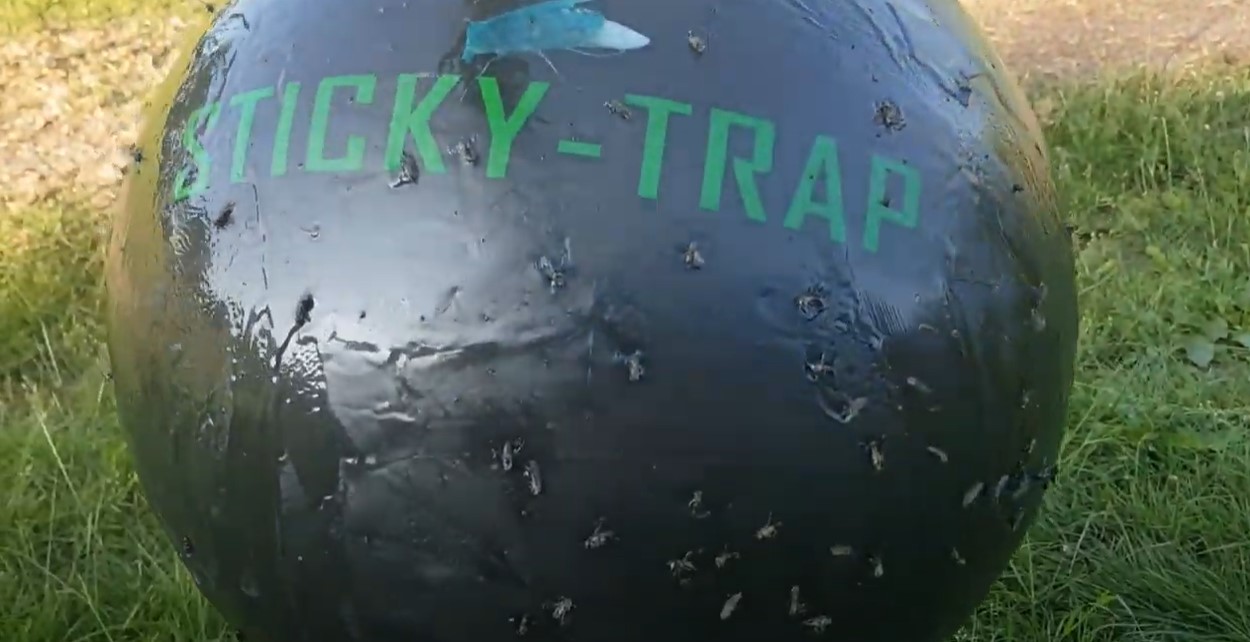
Feeling overwhelmed with so many choices? You would think that choosing a horse fly trap shouldn't cause too much confusion. But the sheer number of options can make anyone double think their pick.
So to help you narrow down the choices and find a horse fly trap that will truly work on your ranch, here's a quick list of things you should consider.
Bait
Considering your horses' surroundings may help you choose the right kind of fly trap. Traps that use odors to bait horse flies and other pests may produce foul smells that can easily overwhelm an enclosed space. For this reason, a biting fly trap that use a scented bait may work best outdoors where smells won't get trapped and pent up.
On the other hand, other traps that use visual bait work best in small spaces like stalls. These traps use specific colors and patterns to lure in horse flies and other flying insects. Because they don't emit an odor, these typically become the trap of choice for stalls and other enclosed spaces.
Container vs Adhesive
The container fly trap usually holds a large number of flies, allowing horse owners to leave the traps for extended periods of time without having to worry about its capacity. The captured pests are trapped in a container that prevents them from getting back out. Some container traps also use adhesive inside that guarantees that pests can't escape.
Other traps use a sticky bait substance that causes flies to adhere to the surface of the trap upon contact. This keeps the pests from escaping and ultimately kills pests in the process. Unlike containers however, adhesive traps only work as long as there's room on the adhesive surface.
As more pests stick to the horse fly trap, the adhesive's viable surface becomes smaller and smaller. So the longer you keep an adhesive trap out, the lesser its chances of catching flies. On the upside, disposing one of these traps takes nothing more than taking down the entire trap and tossing it in the trash.
With container traps on the other hand, there's the issue of emptying the trap. Aside from being an unpleasant experience, you also have to make sure that all the pests contained inside are dead. Otherwise, you'd be simply releasing them back into the area. For instance, it's possible for pests like horn flies to lay horn fly eggs while captured. This means you'd have to kill off the eggs when you empty the system.
Duration of Use
How keen are you on cleaning and resetting the bait of a horse fly trap? Depending on the amount of time and effort you're willing to put into the process, you may have to consider how long these traps last.
An adhesive trap may last no more than a week, calling for routine replacements. If you've got a large ranch with lots of animals and lots of pests, adhesive traps can easily become a major expense on top of the tedious, routine replacements.
Suggested Read: The Best Horse Stall Fans
With containers, you might be looking at a horse fly trap that could last several months or more. With proper cleaning and resetting, these traps can effectively trap flies and other pests without the need for replacements. Of course, you may still have to consider the time it takes to clean it of dead horse flies and reset the bait.
Toxic Materials
Most quality horse fly traps are designed to look bright and visible so as to catch the attention of pests, and to make it easier for you to spot them from a distance. And while this might work to lure pests, the same bright visuals may also cause curious animals to explore the traps.
It's not impossible for a horse to explore its surroundings by nipping and nibbling at new installations around the ranch.
Related: Why do horses chew on wood?
And while it should be your objective to place the traps away from your animals' reach, it doesn't hurt to choose a trap that uses natural baits and materials just in case.
More Options to Keep the Flies at Bay
In addition to choosing a quality horse fly trap, here are more products that will help protect horses from flies:
Frequently Asked Questions
What is the best horse fly bait?
There are lots of items in your kitchen or house that you can use to effectively bait all sorts of pests into your horse fly trap. According to experts, a piece of fruit (preferably close to rotting) can easily lure in a variety of pests. Some species like the stable fly and horn fly are particularly attracted to urine soaked bedding.
Other ways to bait horse flies include apple cider vinegar, soda, fruit juice, a piece of meat or fish, or even a little bit of sugar dissolved in water. Horse flies in particular are highly attracted to sugary drinks.
Is there a trap for horse flies?
Yes. Most fly traps work just fine for all sorts of flying pests. This includes deer flies, yellow flies, biting flies, and Tabanids which are essentially horse flies called green heads. The chances of catching any one kind of stable fly however all depends on whether or not you're using the right kind of bait.
What can I use for a horse fly trap?
If you don't have access to a commercial, quality horse fly trap, then you can resort to DIY methods to catch biting stable flies. Lots of people have had success with just a bottle cut halfway across the middle. The top part is then inverted to form a funnel, and then taped to the bottom half.
The bottom is then filled with about a centimeter depth of sweet water, juice, or soda to start catching horse fly species and more. Although they might have a chance of flying out if they figure out the funnel, the structure traps horse flies when properly designed.
You can also opt for an adhesive spray when making your own horse fly trap or glue trap for fly control. the Tangle Trap Sticky Coating mentioned earlier in this review can easily turn any surface into a horse fly trap with just a few sprays.
Does a horse fly trap work?
Yes, they definitely do. The best horse fly traps reduce painful biting that could irritate your animals. A horse fly control system can also restore heavily infested areas and kill flies that bring disease.
But it takes more than just design to get one of these traps to work. Proper bait and placement play a big role in how effective your horse fly trap will be. Before setting up your trap, make sure you read up about the right kind of bait to use, and read the trap's instructions on proper placement and set-up.
Shoe Fly, Don't Bother Me
A horse fly control system can significantly improve the living conditions for your animals. So if you're worried about your horses getting sick or suffering from painful biting, you should consider getting fly traps.
The best horse fly traps can capture biting pests and various types of flies that could compromise your horses' health otherwise. And with these effective yet simple traps set up around your ranch, you can offer your animals much more comfortable living spaces that reduce the risk of disease.
